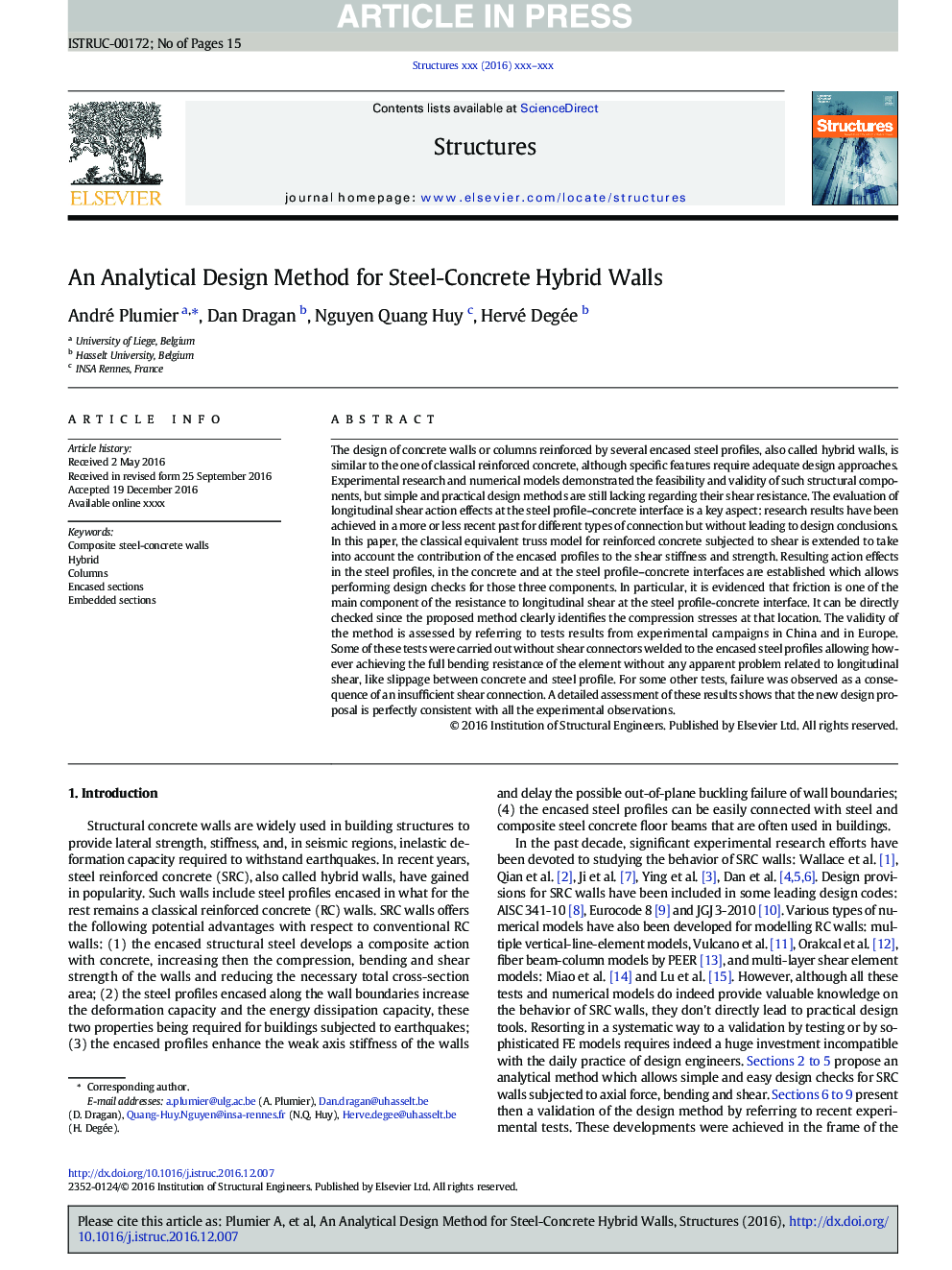| کد مقاله | کد نشریه | سال انتشار | مقاله انگلیسی | نسخه تمام متن |
|---|---|---|---|---|
| 4927956 | 1431998 | 2017 | 15 صفحه PDF | دانلود رایگان |
عنوان انگلیسی مقاله ISI
An Analytical Design Method for Steel-Concrete Hybrid Walls
ترجمه فارسی عنوان
یک روش طراحی تحلیلی برای دیوارهای هیبرید فلزی بتن
دانلود مقاله + سفارش ترجمه
دانلود مقاله ISI انگلیسی
رایگان برای ایرانیان
کلمات کلیدی
دیوارهای فولادی کامپوزیت ترکیبی، ستون ها، قطعه قطعه شده بخش های جاسازی شده،
ترجمه چکیده
طراحی دیوارهای بتنی یا ستون های تقویت شده توسط چندین پروفیل فولادی بسته بندی شده، همچنین دیوارهای هیبریدی نامیده می شود، شبیه به یک بتن مسلح کلاسیک است، اگر چه ویژگی های خاصی نیاز به طراحی مناسب دارد. تحقیقات تجربی و مدل های عددی اثبات امکان و اعتبار چنین اجزای سازنده ای را نشان می دهند، اما روش های طراحی ساده و عملی هنوز در مورد مقاومت برشی خود، فاقد آن هستند. ارزیابی اثرات اثر برشی طولی بر روی رابط پروفیل بتونی فولاد یکی از جنبه های کلیدی است: نتایج تحقیق در گذشته یا بیشتر از گذشته برای انواع اتصال به دست آمده است اما بدون نتیجه گیری طراحی شده است. در این مقاله، مدل کراس معادل کلاسیک برای بتن مسلح تحت برش بکار گرفته شده است تا سهم پروفیل های بسته شده در برابر سختی و مقاومت برشی را در نظر بگیرد. اثرات عمل آورنده در پروفیلهای فولادی، در بتن و در اتصالات پروفیل بتنی فولادی ایجاد شده است که اجازه انجام چک های طراحی برای این سه جزء را می دهد. به طور خاص، نشان داده شده است که اصطکاک یکی از جزء اصلی مقاومت در برابر برش طولی در رابط پروفیل بتن فولادی است. این را می توان به طور مستقیم بررسی کرد زیرا روش پیشنهاد شده به وضوح تنش فشرده سازی در آن محل را مشخص می کند. اعتبار این روش با ارجاع به نتایج آزمون از کمپین های تجربی در چین و اروپا مورد ارزیابی قرار می گیرد. بعضی از این آزمایشها بدون اتصالات برشی جوش داده شده به پروفیل های فولادی پوشش داده شده بود، اما با این حال امکان مقاومت خمشی کامل این عنصر را بدون هیچ گونه مشکل ظاهری مربوط به برش طولی، مانند لغزش بین پروفیل بتن و فولاد به دست آورد. برای برخی از آزمون های دیگر، شکستگی به عنوان یک نتیجه از یک اتصال برش ناکافی مشاهده شد. ارزیابی دقیق این نتایج نشان می دهد که طرح طراحی جدید کاملا با تمام مشاهدات تجربی سازگار است.
موضوعات مرتبط
مهندسی و علوم پایه
سایر رشته های مهندسی
مهندسی عمران و سازه
چکیده انگلیسی
The design of concrete walls or columns reinforced by several encased steel profiles, also called hybrid walls, is similar to the one of classical reinforced concrete, although specific features require adequate design approaches. Experimental research and numerical models demonstrated the feasibility and validity of such structural components, but simple and practical design methods are still lacking regarding their shear resistance. The evaluation of longitudinal shear action effects at the steel profile-concrete interface is a key aspect: research results have been achieved in a more or less recent past for different types of connection but without leading to design conclusions. In this paper, the classical equivalent truss model for reinforced concrete subjected to shear is extended to take into account the contribution of the encased profiles to the shear stiffness and strength. Resulting action effects in the steel profiles, in the concrete and at the steel profile-concrete interfaces are established which allows performing design checks for those three components. In particular, it is evidenced that friction is one of the main component of the resistance to longitudinal shear at the steel profile-concrete interface. It can be directly checked since the proposed method clearly identifies the compression stresses at that location. The validity of the method is assessed by referring to tests results from experimental campaigns in China and in Europe. Some of these tests were carried out without shear connectors welded to the encased steel profiles allowing however achieving the full bending resistance of the element without any apparent problem related to longitudinal shear, like slippage between concrete and steel profile. For some other tests, failure was observed as a consequence of an insufficient shear connection. A detailed assessment of these results shows that the new design proposal is perfectly consistent with all the experimental observations.
ناشر
Database: Elsevier - ScienceDirect (ساینس دایرکت)
Journal: Structures - Volume 9, February 2017, Pages 185-199
Journal: Structures - Volume 9, February 2017, Pages 185-199
نویسندگان
André Plumier, Dan Dragan, Nguyen Quang Huy, Hervé Degée,
